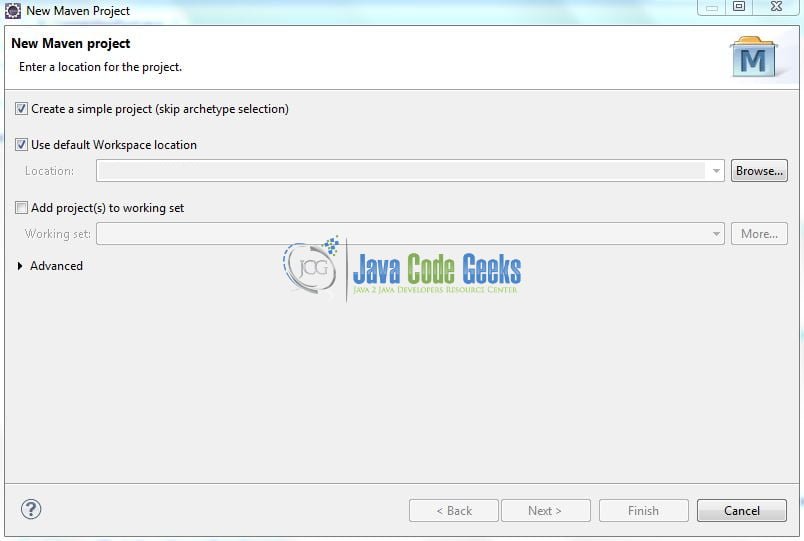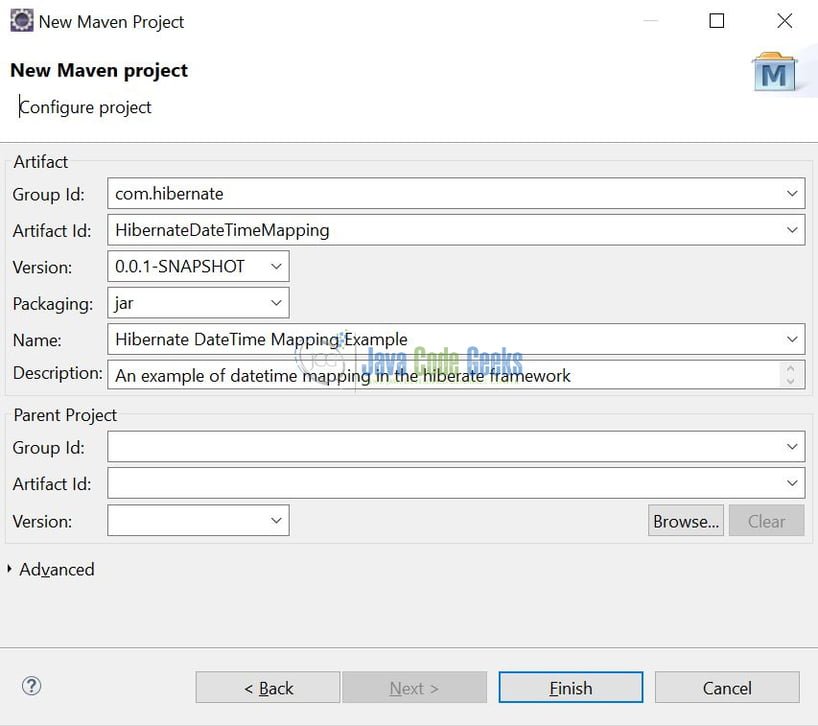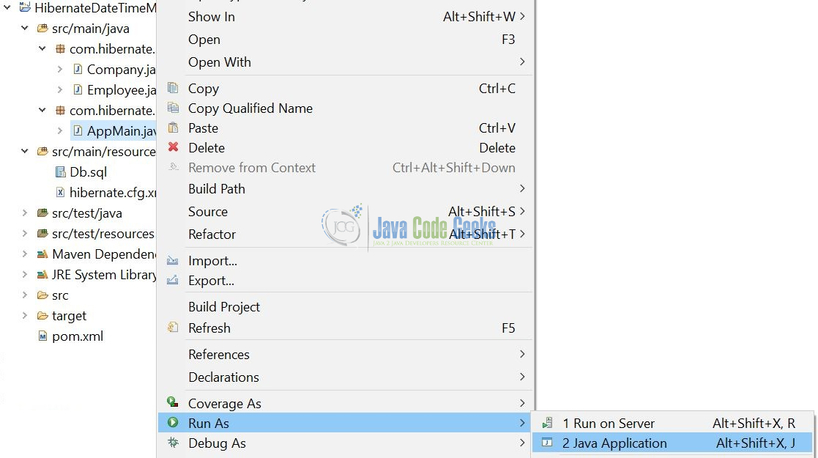Hibernate DateTime Mapping Example
In hibernate; @Temporal annotation is used to store java.sql.Time, java.sql.Date or java.sql.Timestamp in the database. In this tutorial, we will explore how to work with Timestamp using the xml and annotation configurations in the Hibernate framework.
1. Introduction
- Object-Relational Mapping or ORM is the programming technique to map application domain model objects to the relational database tables
- Hibernate is a Java-based ORM tool that provides the framework for mapping application domain objects to the relational database tables and vice versa. It provides the reference implementation of Java Persistence API that makes it a great choice as an ORM tool with benefits of loose coupling
- A Framework that an option to map plain old Java objects to the traditional database tables with the use of JPA annotations as well as
XMLbased configuration
1.1 Hibernate Annotations
- Hibernate annotations are the newest way to define mappings without the use of a
XMLfile - Developers use annotations to provide metadata configuration along with the Java code. Thus, making the code easy to understand
- XML provides the ability to change the configuration without building the project. Thus, annotations are less powerful than the
XMLconfiguration and should only be used for table and column mappings - Annotations are preconfigured with sensible default values, which reduce the amount of coding required. For e.g., Class name defaults to Table name and Field names default to Column names
1.2 @Temporal annotation in Hibernate
@Temporalannotation in Hibernate is used with the pojo properties of typejava.util.Dateandjava.util.Calendar@Temporalannotation automatically converts the date and time values from the Java object to the compatible database type- There are 3 types of temporal in the hibernate framework i.e.
TemporalType.TIMESTAMPmaps the date asjava.sql.TimestampTemporalType.DATEmaps the date asjava.sql.DateTemporalType.TIMEmaps the date asjava.sql.Time
1.3 Download and Install Hibernate
You can read this tutorial in order to download and install Hibernate in the Eclipse IDE.
1.4 Download and Install MySQL
You can watch this video in order to download and install the MySQL database on your Windows operating system.
Now, open up the Eclipse IDE and let us see how to implement this tutorial in the hibernate framework!
2. Hibernate DateTime Mapping Example
Here is a systematic guide for implementing this tutorial in the hibernate framework.
2.1 Tools Used
We are using Eclipse Kepler SR2, JDK 8, MySQL database and Maven. Having said that, we have tested the code against JDK 1.7 and it works well.
2.2 Project Structure
Firstly, let us review the final project structure, in case you are confused about where you should create the corresponding files or folder later!
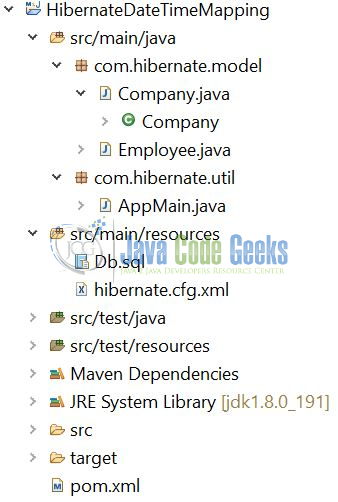
2.3 Project Creation
This section will demonstrate how to create a Java-based Maven project with Eclipse. In Eclipse IDE, go to File -> New -> Maven Project.
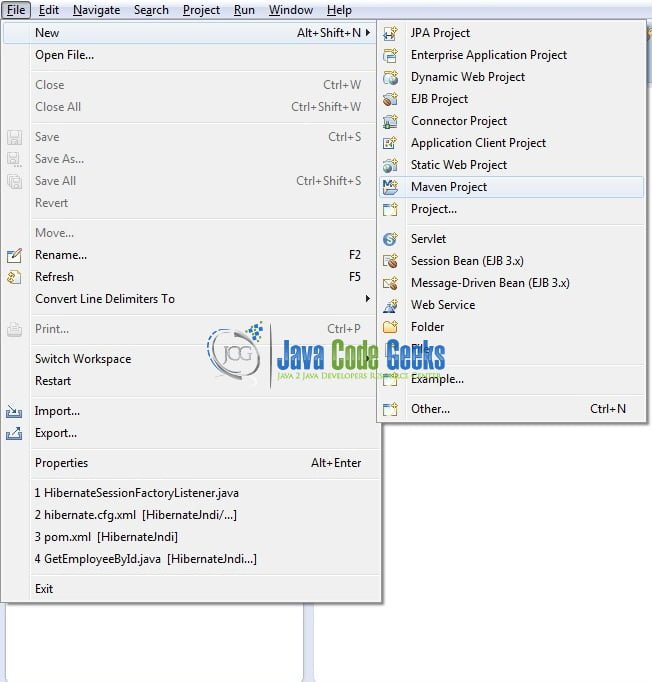
In the New Maven Project window, it will ask you to select the project location. By default, ‘Use default workspace location’ will be selected. Select the ‘Create a simple project (skip archetype selection)’ checkbox and just click on the next button to proceed.
It will ask you to ‘Enter the group and the artifact id for the project’. We will input the details as shown in the below image. The version number will be by default: 0.0.1-SNAPSHOT.
Click on Finish and the creation of a maven project is completed. If you observe, it has downloaded the maven dependencies and a pom.xml file will be created. It will have the following code:
pom.xml
<project xmlns="http://maven.apache.org/POM/4.0.0" xmlns:xsi="http://www.w3.org/2001/XMLSchema-instance" xsi:schemaLocation="http://maven.apache.org/POM/4.0.0 http://maven.apache.org/xsd/maven-4.0.0.xsd"> <modelVersion>4.0.0</modelVersion> <groupId>com.hibernate</groupId> <artifactId>HibernateDateTimeMapping</artifactId> <version>0.0.1-SNAPSHOT</version> <name>Hibernate DateTime Mapping Example</name> <packaging>jar</packaging> </project>
We can start adding the dependencies that developers want like Hibernate, MySQL etc. Let us start building the application!
3. Application Building
Below are the steps involved in developing this application.
3.1 Database and Table Creation
The following script creates a database called datetimedb. Open MySQL terminal and execute the script.
CREATE DATABASE IF NOT EXISTS datetimedb; USE datetimedb;
If everything goes well, the database will be created.
3.2 Maven Dependencies
Here, we specify the dependencies for the Hibernate framework and the MySQL connector. Maven will automatically resolve the rest dependencies such as Hibernate Core, MySQL etc. The updated file will have the following code:
pom.xml
<project xmlns="http://maven.apache.org/POM/4.0.0" xmlns:xsi="http://www.w3.org/2001/XMLSchema-instance" xsi:schemaLocation="http://maven.apache.org/POM/4.0.0 http://maven.apache.org/xsd/maven-4.0.0.xsd">
<modelVersion>4.0.0</modelVersion>
<groupId>com.hibernate</groupId>
<artifactId>HibernateDateTimeMapping</artifactId>
<version>0.0.1-SNAPSHOT</version>
<name>Hibernate DateTime Mapping Example</name>
<description>An example of datetime mapping in the hibernate framework</description>
<packaging>jar</packaging>
<dependencies>
<!-- https://mvnrepository.com/artifact/org.hibernate/hibernate-core -->
<dependency>
<groupId>org.hibernate</groupId>
<artifactId>hibernate-core</artifactId>
<version>5.3.7.Final</version>
</dependency>
<!-- https://mvnrepository.com/artifact/mysql/mysql-connector-java -->
<dependency>
<groupId>mysql</groupId>
<artifactId>mysql-connector-java</artifactId>
<version>8.0.13</version>
</dependency>
</dependencies>
<build>
<finalName>${project.artifactId}</finalName>
</build>
</project>
3.3 Java Class Creation
Let us write the Java classes involved in this application.
3.3.1 Implementation of Company Class
The entity class has a field called doj which is defined as a java.util.Date variable. Add the following code to the model definition to map the attributes with the column names.
Company.java
package com.hibernate.model;
import java.util.Date;
import javax.persistence.Entity;
import javax.persistence.GeneratedValue;
import javax.persistence.GenerationType;
import javax.persistence.Id;
import javax.persistence.ManyToOne;
import javax.persistence.Table;
import javax.persistence.Temporal;
import javax.persistence.TemporalType;
@Entity
@Table(name= "company")
public class Company {
@Id
@GeneratedValue(strategy= GenerationType.IDENTITY)
private int cid;
private String cname;
@Temporal(value= TemporalType.TIMESTAMP)
private Date doj;
@ManyToOne
private Employee employee;
public int getCid() {
return cid;
}
public void setCid(int cid) {
this.cid = cid;
}
public String getCname() {
return cname;
}
public void setCname(String cname) {
this.cname = cname;
}
public Date getDoj() {
return doj;
}
public void setDoj(Date doj) {
this.doj = doj;
}
public Employee getEmployee() {
return employee;
}
public void setEmployee(Employee employee) {
this.employee = employee;
}
}
3.3.2 Implementation of Employee Class
Add the following code to the model definition to map the attributes with the column names.
Employee.java
package com.hibernate.model;
import java.util.ArrayList;
import java.util.List;
import javax.persistence.CascadeType;
import javax.persistence.Entity;
import javax.persistence.GeneratedValue;
import javax.persistence.GenerationType;
import javax.persistence.Id;
import javax.persistence.OneToMany;
import javax.persistence.Table;
@Entity
@Table(name= "employee")
public class Employee {
@Id
@GeneratedValue(strategy= GenerationType.IDENTITY)
private int eid;
private String ename;
@OneToMany(mappedBy= "employee", cascade= CascadeType.ALL)
private List<Company> companies = new ArrayList<Company>();
public int getEid() {
return eid;
}
public void setEid(int eid) {
this.eid = eid;
}
public String getEname() {
return ename;
}
public void setEname(String ename) {
this.ename = ename;
}
public List<Company> getCompanies() {
return companies;
}
public void setCompanies(List<Company> companies) {
this.companies = companies;
}
}
3.3.3 Implementation of Utility Class
Add the following code to the implementation class for testing the DateTime mapping in the Hibernate framework.
AppMain.java
package com.hibernate.util;
import java.util.Date;
import java.util.List;
import org.hibernate.Session;
import org.hibernate.cfg.Configuration;
import com.hibernate.model.Company;
import com.hibernate.model.Employee;
public class AppMain {
public static void main(String[] args) {
// Creating the config instance & passing the hibernate config file.
Configuration config = new Configuration();
config.configure("hibernate.cfg.xml");
// Hibernate session object to start the db transaction.
Session s = config.buildSessionFactory().openSession();
Employee emp = new Employee();
emp.setEname("John Lark");
Date joiningDate = new Date();
Company comp1 = new Company();
comp1.setCname("Abc pvt. ltd.");
comp1.setDoj(joiningDate);
comp1.setEmployee(emp);
Company comp2 = new Company();
comp2.setCname("Xyz pvt. ltd.");
comp2.setDoj(joiningDate);
comp2.setEmployee(emp);
emp.getCompanies().add(comp1);
emp.getCompanies().add(comp2);
// Saving the data in the database.
s.getTransaction().begin();
s.save(emp);
s.getTransaction().commit();
// Fetching the data from the database.
System.out.println(":::: Employee Details ::::");
int eid = 1;
Employee employee = s.get(Employee.class, eid);
System.out.println(employee.getEid() + "\t" + employee.getEname());
List<Company> companies = employee.getCompanies();
for(Company c : companies) {
System.out.println(c.getCid() + "\t" + c.getCname() + "\t" + c.getDoj());
}
// Closing the session object.
s.close();
}
}
3.4. Hibernate Configuration File
In the configuration file, we will include the database and the mapping class details.
hibernate.cfg.xml
<?xml version="1.0" encoding="UTF-8"?> <!DOCTYPE hibernate-configuration PUBLIC "-//Hibernate/Hibernate Configuration DTD 3.0//EN" "http://www.hibernate.org/dtd/hibernate-configuration-3.0.dtd"> <hibernate-configuration> <session-factory> <!-- Database connection settings --> <property name="hibernate.connection.driver_class">com.mysql.cj.jdbc.Driver</property> <property name="hibernate.connection.url">jdbc:mysql://localhost:3306/datetimedb</property> <property name="hibernate.connection.username">root</property> <property name="hibernate.connection.password" /> <!-- Sql dialect --> <property name="hibernate.dialect">org.hibernate.dialect.MySQL5Dialect</property> <!-- Printing the sql queries to the console --> <property name="show_sql">true</property> <!-- Mapping to the create schema DDL --> <property name="hbm2ddl.auto">create</property> <!-- Model class --> <mapping class="com.hibernate.model.Employee" /> <mapping class="com.hibernate.model.Company" /> </session-factory> </hibernate-configuration>
Important points:
- Here, we instructed Hibernate to connect to a MySQL database named
datetimedband the mapping class to be loaded - We have also instructed the Hibernate framework to use
MySQL5Dialecti.e. Hibernate will optimize the generated SQL statements for MySQL - This configuration will be used to create a hibernate
SessionFactoryobject hbm2ddl.autotag will instruct the hibernate framework to create the database table schema at the application startupshow_sqltag will instruct the hibernate framework to log all the SQL statements on the console
4. Run the Application
To run the Hibernate application, Right-click on the AppMain class -> Run As -> Java Application. Developers can debug the example and see what happens after every step!
5. Project Demo
The code shows the following logs as the output of this tutorial.
Hibernate: drop table if exists company Dec 04, 2018 9:58:25 AM org.hibernate.resource.transaction.backend.jdbc.internal.DdlTransactionIsolatorNonJtaImpl getIsolatedConnection INFO: HHH10001501: Connection obtained from JdbcConnectionAccess [org.hibernate.engine.jdbc.env.internal.JdbcEnvironmentInitiator$ConnectionProviderJdbcConnectionAccess@3add81c4] for (non-JTA) DDL execution was not in auto-commit mode; the Connection 'local transaction' will be committed and the Connection will be set into auto-commit mode. Hibernate: drop table if exists employee Hibernate: create table company (cid integer not null auto_increment, cname varchar(255), doj datetime, employee_eid integer, primary key (cid)) engine=MyISAM Dec 04, 2018 9:58:25 AM org.hibernate.resource.transaction.backend.jdbc.internal.DdlTransactionIsolatorNonJtaImpl getIsolatedConnection INFO: HHH10001501: Connection obtained from JdbcConnectionAccess [org.hibernate.engine.jdbc.env.internal.JdbcEnvironmentInitiator$ConnectionProviderJdbcConnectionAccess@7ee55e70] for (non-JTA) DDL execution was not in auto-commit mode; the Connection 'local transaction' will be committed and the Connection will be set into auto-commit mode. Hibernate: create table employee (eid integer not null auto_increment, ename varchar(255), primary key (eid)) engine=MyISAM Hibernate: alter table company add constraint FKjd4lb0wftdng95ivxbg5lo9v foreign key (employee_eid) references employee (eid) Dec 04, 2018 9:58:25 AM org.hibernate.tool.schema.internal.SchemaCreatorImpl applyImportSources INFO: HHH000476: Executing import script 'org.hibernate.tool.schema.internal.exec.ScriptSourceInputNonExistentImpl@46292372' Hibernate: insert into employee (ename) values (?) Hibernate: insert into company (cname, doj, employee_eid) values (?, ?, ?) Hibernate: insert into company (cname, doj, employee_eid) values (?, ?, ?) :::: Employee Details :::: 1 John Lark 1 Abc pvt. ltd. Tue Dec 04 09:58:25 IST 2018 2 Xyz pvt. ltd. Tue Dec 04 09:58:25 IST 2018
That is all for this tutorial and I hope the article served you whatever you were looking for. Happy Learning and do not forget to share!
6. Conclusion
This post defines the implementation of the DateTime mapping in the Hibernate framework and helps developers understand the basic configuration required to achieve this. Developers can download the sample application as an Eclipse project in the Downloads section.
7. Download the Eclipse Project
This was an example of DateTime mapping in the Hibernate framework for beginners.
You can download the full source code of this example here: HibernateDateTimeMapping


